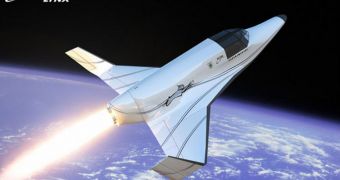A new Memorandum of Understanding has been signed between XCOR Aerospace and the Planetary Science Institute (PSI). The document states that the human-operated Atsa Suborbital Observatory will conduct a series of observations from aboard Lynx spacecraft operated by XCOR.
The understanding calls for PSI to have access to low-cost, space-based observations using its telescope. The special instrument will be operated from aboard the Lynx, which is a manned, reusable, suborbital spacecraft capable of spending several minutes in low-Earth orbit (LEO).
One of the main reasons why this contract was signed is the fact that PSI wants to have access to an area in the atmosphere that is above contaminated layers. This way, scientist operating Atsa avoid all sorts of interferences from various sources of electromagnetic waves.
While flying aboard the Lynx, Atsa operators also dispense with some of the limitations that have traditionally plagues classic orbital telescopes. Some time ago, it became apparent that the only sensible course of action for the Institute was to search for a suborbital spacecraft.
The issue that arose immediately after this conclusion was reached was which launch system to select. There are several companies like XCOR, all of them producing orbital or suborbital spacecraft that could conceivably be modified to fit Atsa.
“The XCOR vehicle design and capabilities work well for hosting the kind of observing facility we are developing,” explains Faith Vilas, the Atsa project scientist, and a senior scientist at the Institute.
Working together with PSI affiliate scientist Luke Sollitt, Vilas designed and developed the Atsa Suborbital Observatory (ASO). Sollitt also holds an appointment with the Military College of South Carolina, and is a former staff scientist at Northrop Grumman.
Before joining the PSI, Vilas worked as a planetary astronomer, and as the director of the MMT Observatory. The latter is a joint facility of the Smithsonian Institution and the University of Arizona, SpaceRef reports.
“NASA has been flying suborbital observatories for decades, on unmanned, disposable rockets. The new manned, reusable commercial platforms will allow us to make repeated observations with a single instrument, but without the need to refurbish it between flights,” Sollitt explains.
“In addition, the short turn-around means we can do many observations or targets,” he goes on to say, explaining that Atsa is designed specifically to study hard-to-see objects in close proximity to the Sun.
“These are natural targets for instruments on suborbital rockets to observe, but a human-tended facility using the kind of reusable launch vehicle offered by XCOR offers significant cost savings,” concludes PSI CEO and director Mark Sykes.

 14 DAY TRIAL //
14 DAY TRIAL //